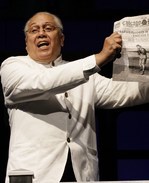SITE GUIDE
SEARCH
REVIEWS
REVIEW ARCHIVES
ADVERTISING AT CURTAINUP
FEATURES
NEWS
Etcetera and
Short Term Listings
LISTINGS
Broadway
Off-Broadway
NYC Restaurants
BOOKS and CDs
OTHER PLACES
Berkshires
London
California
New Jersey
DC
Connecticut
Philadelphia
Elsewhere
QUOTES
TKTS
PLAYWRIGHTS' ALBUMS
LETTERS TO EDITOR
FILM
LINKS
MISCELLANEOUS
Free Updates
Masthead
A CurtainUp DC Review
Pullman Porter Blues
|
“A man carries his life to the end of the line.” —A Pullman porter’s motto.
|

Larry Marshall as Monroe
(Photo by Chris Bennion) |
The elements are there: a good story line – four generations and their relationship to the railroad – and glorious Blues songs such as “Sweet Home Chicago,” and “Trouble in Mind” played by an onstage quartet. But Pullman Porter Blues gets sidetracked by extraneous characters such as Lutie Duggernut, the stowaway (a vigorous performance by Emily Chisholm) and repetitive exposition.
The show is set on the Panama Limited Pullman train in June, 1937, on the eve of Joe Lewis’s historic boxing match. It comes alive every time the three generations of Pullman Porters played by Larry Marshall, Cleavant Derricks and Warner Miller sing and dance — particularly Larry Marshall who in spite of his age and heft dances like a light-footed and rubber-limbed teenager. His stylish moves are the evening’s high point. Another standout is E. Faye Butler’s Sister Juba, a boozey seen-it-all broad who, like many others on the train, has a hard-luck background. Butler belts “Wild Women Don’t Have the Blues,” and a very moving “Grievin’ Hearted Blues” and she too is remarkably graceful when she shimmies. Be prepared though for some humorous vulgarity as she lets it all hang out.
Alexander Nichols’s set evokes an era and a mode of travel that seem far far away from today’s travel and costumer Constanza Romero dresses Sister Juba splendidly.
A co-production with the Seattle Repertory Theatre, Pullman Porter Blues, feels like a work in process. With more music and less words, it could really make good time but right now it just chugs along.
|
Pullman Porter Blues
By Cheryl L. West Director, Lisa Peterson Music Director, JMichael Set Designer, Riccardo Hernandez Costume Designer, Constanza Romero Lighting and Projection Designer, Leon Rothenberg Dance Captain, Emily Chisholm Cast: Cleavant Derricks (Sylvester); Larry Marshall (Monroe); Warner Miller (Cephas); James Patrick Hill (Twist/Drummer); Chic Street Man (Slick Guitarist); Lamar Lofton (Shorty/Bassist); JMichael (Keys/Pianist); E. Faye Butler (Sister Juba); Richard Ziman (Tex/Voices); Emily Chisholm (Lutie Duggernut). Running time: 2 hours 35 minutes with one intermission. Performances November 23, 2012 to January 6, 2013. Tickets, $45 to $94. Arena Stage/Kreeger Theater, 1101 Sixth Street, SW; Washington, DC; 202-554-9066; www.arenastage.org Review by Susan Davidson based on November 29, 2012 performance. Musical Numbers Act One: “Hezekiah’s Song,” “This Train,” “Sweet Home Chicago,” “Wild Women Don’t Have the Blues,” “Panama Limited Chant,” “Panama Limited Blues,” “900 Miles,” “Joe Louis Blues.” Musical Numbers Act Two: “Hop Scop Blues,” “That Lonesome Train Took My Baby Away,” “Trouble in Mind,” “Grievin’ Hearted Blues,” “Hezekiah’s Song.” |
|
REVIEW FEEDBACK Highlight one of the responses below and click "copy" or"CTRL+C"
For a feed to reviews and features as they are posted add http://curtainupnewlinks.blogspot.com to your reader Curtainup at Facebook . . . Curtainup at Twitter Subscribe to our FREE email updates: E-mail: esommer@curtainup.comesommer@curtainup.com put SUBSCRIBE CURTAINUP EMAIL UPDATE in the subject line and your full name and email address in the body of the message |


 Book of Mormon -CD
Book of Mormon -CD